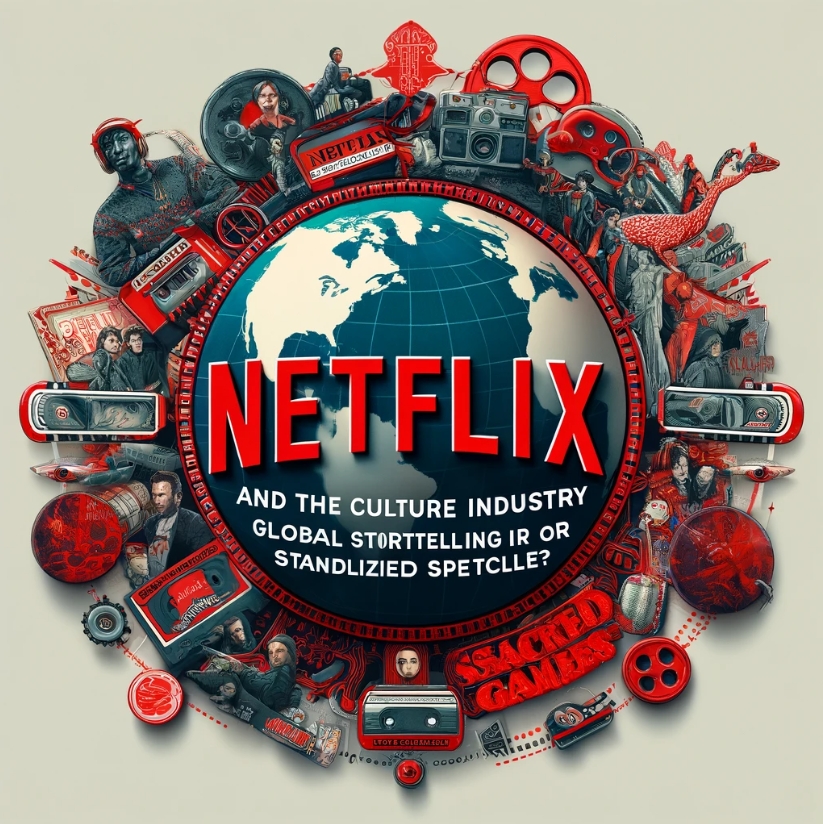Introduction
The Culture Industry, as developed by Adorno and Horkheimer (2002), questions how cultural products are now mass-manufactured, standardized, and generated in the interest of profit in a capitalist environment. Netflix exemplifies this personification in the modern period with its reliance on algorithms, formulaic content, and global reach. Although this platform creates the ability to access entertainment nonstop, this fuels questions of creativity, authenticity, and cultural homogenization.
🌟 Algorithm-Driven Creativity 🌟
Netflix’s recommendation algorithm personalizes user experiences, suggesting titles based on viewing history, genres, and engagement patterns. While this creates a tailored viewing experience, it also reinforces Koç’s (2023) argument that such algorithms commodify cultural production by prioritizing predictable, formulaic content over originality. For example, Netflix Originals like Stranger Things combine nostalgic 1980s aesthetics, diverse ensemble casts, and cliffhanger endings—elements carefully calculated to maximize binge-watching.
This formula has proved extremely successful but indicates the Culture Industry’s reliance upon repetition. Viewers are caught within patterns of familiarity, which foster consumption without critical reflection-a concern voiced by Adorno and Horkheimer with regard to the homogenization of cultural products in 2002.
🌟 Globalization Meets Standardization 🌟
Netflix’s global expansion introduces local stories to international audiences but often adapts these narratives to fit Western-centric tastes. For instance, the Indian series Sacred Games, which explores themes of corruption and spirituality, was marketed globally but incorporated Hollywood-style pacing and cliffhangers to ensure accessibility. Davis (2023) argues that Netflix’s monopolistic aspirations drive the platform to prioritize global marketability over preserving local authenticity.
This represents the tension between diversity and uniformity within the Culture Industry. The same platforms that can bring an international story to a new audience also standardize production values that erase nuances of difference in those narratives.
🌟 Genre-Based Standardization 🌟
In fact, Netflix’s reliance on specific genres, such as teen dramas and true crime documentaries, is evidence that the streamer identifies and repeats successful formulas. For instance, the success of Making a Murderer led to a spate of similar titles: The Tinder Swindler and Don’t Fuck with Cats. Each of these similarly blankets viewers with an incessant procession of shocking revelations and dramatized reconstructions, predictable in its trajectory-high in engagement value, low in innovative appeal.
According to Adorno and Horkheimer (2002), this kind of standardized cultural production commodifies creativity. Netflix finds itself repeatedly within this critique, wherein content is formulaic to maximize viewer retention and profitability through genre-based standardization.
🌟 Conclusion🌟
Netflix simultaneously represents both the promises and pitfalls of the contemporary Culture Industry: democratizing access to stories from every corner of the world, reinforcing through its reliance on standardized formats and algorithms a stifling of originality. Viewers have to engage in critical consumption of what they watch, being aware of the fine line between entertainment and commodification.
By marrying creative storytelling with market-driven strategies, Netflix continues to reshape global culture. Yet, as Adorno and Horkheimer (2002) noted, “The triumph of culture industry is its perversion of creativity into consumption.” This reflection invites us to consider how we, as consumers, can demand more diverse and innovative narratives in the age of algorithmic entertainment.
Reference List
- Davis, S. (2023). What is Netflix imperialism? Interrogating the monopoly aspirations of the ‘World’s largest television network’. Information, Communication & Society, 26(6), 1143-1158.
- Horkheimer, M., Adorno, T. W., & Noeri, G. (2002). Dialectic of enlightenment. Stanford University Press.
- Koç, B. İ. R. K. A. N. (2023). The Role of User Interactions In Social Media On Recommendation Algorithms: Evaluation of Tiktok’s Personalization Practices From User’s Perspective[Istanbul University].

